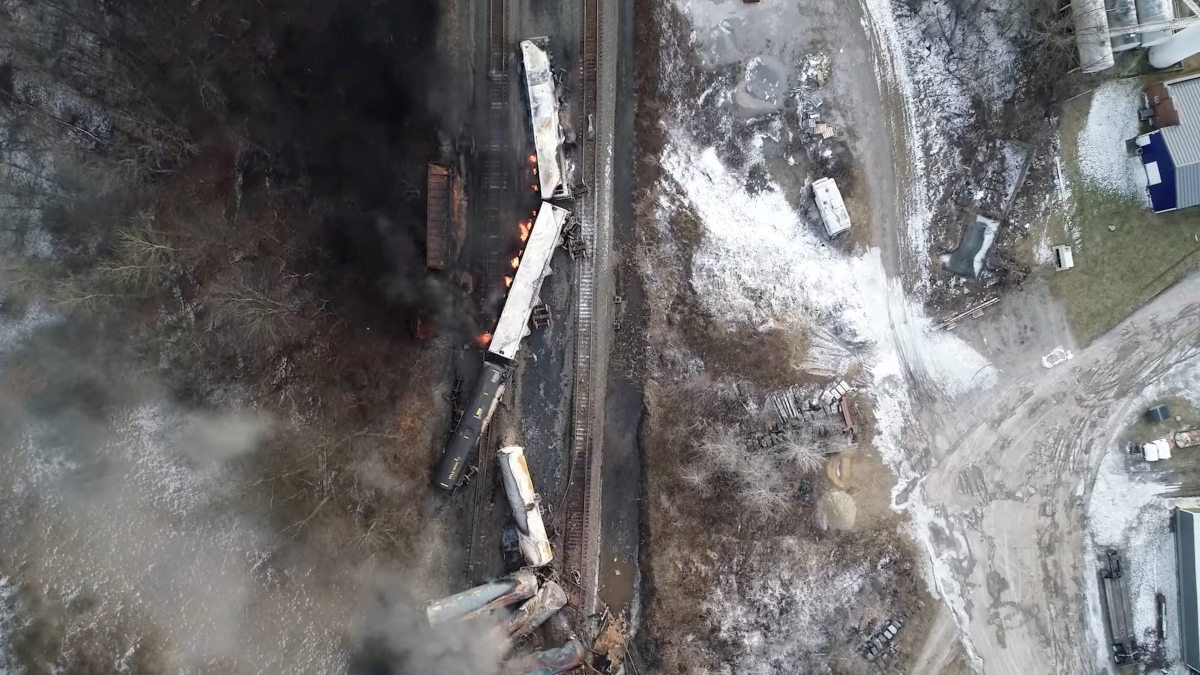SUMMARY
This is AI generated summarization, which may have errors. For context, always refer to the full article.

Cleanup is moving quickly after a train carrying toxic materials derailed in Ohio 11 days ago, Ohio Governor Mike DeWine said on Tuesday, Febraury 14, while residents and observers questioned the health impacts of pollution that spilled into the Ohio River.
The Norfolk Southern Railroad-operated train derailed on February 3, causing a fire that sent a cloud of smoke over the town of East Palestine, Ohio, and forcing thousands of residents to evacuate. After railroad crews drained and burned off a toxic chemical from five tanker cars, DeWine on February 8 said that residents could return to their homes.
While DeWine said the pollution did not pose a serious threat to five million people who rely on the river for drinking water, he and several Ohio health and environmental officials cautioned at an afternoon press conference that residents using private wells near the derailment should only use bottled water.
Reporters pressed DeWine and other officials about some residents’ complaints of headaches and concern that the government or the railroad were not telling them the entire truth about the pollution and potential harm.
One of the chemicals on the train was vinyl chloride, which the U.S. Environmental Protection Agency says is highly flammable and carcinogenic, especially through inhalation. When burned, it decomposes into other toxic compounds including hydrogen chloride.
Dr. Bruce Vanderhoff, director of the Ohio Department of Health, said the compounds spilled can cause headaches, eye and nose irritation even at levels considered safe, but that the “measured facts” show air sampling is not reporting any dangers.
The plume of pollution in the Ohio River is moving at one mile per hour (1.61 kilometers per hour) toward the Mississippi River, nearing Huntington, West Virginia, on Tuesday afternoon, said Tiffany Kavalec, chief of the surface water division of the Ohio Environmental Protection Agency.
Cities in the plume’s path can turn off their drinking water intakes as it floats by, Kavalec said. Drinking water tests have not raised concerns and normal water treatment would remove any small amounts of contaminants that may exist, Kavalec said.
Officials said the volume of the river diluted the plume and the plume did not pose a serious threat.
Union warnings
Railroad union officials said they have been warning that such an accident could happen because railroad cost-cutting harmed safety measures.
Asked about the union accusations, a spokesperson for Norfolk Southern Railroad said in an email that “our record (and that of most US Class I railroads) is trending safer.”
The train of three locomotives and 150 freight cars was headed from Illinois to Pennsylvania when it derailed. The National Transportation Safety Board (NTSB) said 20 of the cars were carrying hazardous materials, including 10 that derailed.
The NTSB said 38 cars in total left the tracks and that the ensuing fire damaged an additional 12. The NTSB has not commented on the derailment’s cause.
Clyde Whitaker, chairman and director of the Ohio State Legislative Board for the International Association of Sheet Metal, Air, Rail and Transportation Workers Transportation Division (SMART-TD) said he had notified federal railroad inspectors that crews at one railroad, which he would not name, were disregarding warnings from detectors designed to prevent accidents and was told that their use is voluntary and not subject to regulation.
“No one wants to listen until we have a town blown off the face of the earth, then people listen,” said Whitaker, whose union is the largest U.S. railroad union representing conductors, engineers and other workers.
DeWine said that he spoke with Norfolk Southern CEO Alan Shaw on Tuesday morning.
“I asked if he would personally guarantee that the railroad would stay there until absolutely everything was clean. He gave me his word and his commitment that the railroad would do that, they would not leave until that was done,” the governor said.
The federal Environmental Protection Agency (EPA) had earlier notified the company it may be liable for cleaning up under the US Superfund law. – Rappler.com
Add a comment
How does this make you feel?
There are no comments yet. Add your comment to start the conversation.